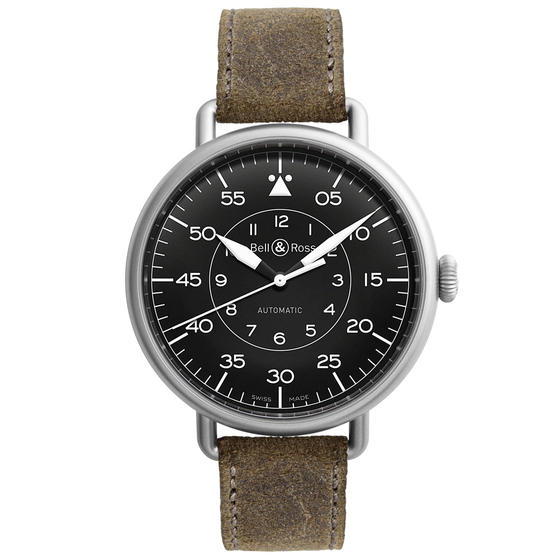Where does the wristwatch come from? Throughout the years, clocks have been made for classrooms, office cubicles and even televisions and VCRs because we have a natural desire to tell time. An employee checks the clock to see if his lunch break is drawing near. A mother might check the clock to see if that special batch of brownies is ready to emerge from the oven, and kids might check the clock because they’re bored with everything their teachers have to say, and they’re eager to dash home to the comfort of video games, snack bowls and comic books.
But for the last 100 years, people have had the urge to wear clocks on their wrists. What started such a practice? Is our need to know the exact hour every hour really that pressing? Well, not exactly…
Bell & Ross Vintage WW1 BRWW192-MIL/SCA
Fads have come and gone throughout the years. In the 60s, it was bellbottoms and tie-dye. The 70s gave us Disco, and in the 90s, young men spent hours in front of the mirror delicately spiking their hair.
But some fads have refused to vanish, and watch-wearing has lasted for nearly a century. The craze began in 1916, two years into WWI and the same year Baselworld made its first impression on society. European soldiers, stuck in the trenches and facing life-or-death situations on a daily basis in the name of the motherland, were often reported wearing “clock-bracelets,” enabling them to determine the time with accuracy and far more ease than the standard pocket watch that was still so popular among civilians. Coordination of precise movements and maneuvers would require all soldiers to be in synch with each other, and present technological advancements through the new “wrist watch” would enable such possibilities.
Prior to the war, wearing a watch on one’s arm had remained primarily popular amongst the female crowd, but tales of soldiers and their methods of timekeeping were now making their way into the hearts of all who heard them. Suddenly, wearing a clock-bracelet wasn’t just a “girl-thing,” and men acquired a newfound eagerness to join the ranks of the time-telling population.

Image credit: health.howstuffworks.com
Aside from defending their national turf, soldiers have been relatively proficient when it comes to pushing trends. Buzz cuts have been consistently popular, and 20 years ago it wasn’t strange to witness students wandering about their school grounds wearing camouflage jackets and army pants, but the wristwatch has had a lasting impact that the majority of us still take very seriously. Whether you’re a single watch owner or a long-time collector with a massive assortment, a good watch on one’s wrist is always something to appreciate.
So it’s probably safe to say that soldiers have not only given us protection, they’ve given us “time;” time to prepare, time to get out of harm’s way, and time in “miniature” form. So let’s raise our “hands” in honor of the brave men and women who continue to devote their lives to national security. Their gift to their country is long-lasting and exemplary.
For a complete list of military timepieces that are in stock and available to ship immediately, please see the following page: AuthenticWatches.com Military Timepieces
1. Friedman, Uri. “A Brief History of the Wristwatch.” The Atlantic. Atlantic Media Company, 27 May 2015. Web. 21 Apr. 2016.

